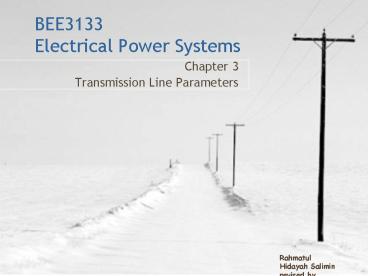BEE3133 Electrical Power Systems - PowerPoint PPT Presentation
1 / 32
Title:
BEE3133 Electrical Power Systems
Description:
All transmission lines in a power system exhibit the electrical properties of ... For nonmagnetic material, the inductance L is the ratio of its total magnetic ... – PowerPoint PPT presentation
Number of Views:503
Avg rating:3.0/5.0
Title: BEE3133 Electrical Power Systems
1
BEE3133 Electrical Power Systems
- Chapter 3
- Transmission Line Parameters
Rahmatul Hidayah Salimin revised by Ramdan Razali
2
INTRODUCTION
3
INTRODUCTION
Transmission line is non ideal, therefore cannot
be assumed that the wires that transmit
electricity are loss less.
4
INTRODUCTION
- All transmission lines in a power system exhibit
the electrical properties of resistance,
inductance, capacitance and conductance. - Inductance and capacitance are due to the effects
of magnetic and electric fields around the
conductor. - These parameters are essential for the
development of the transmission line models used
in power system analysis.
a model of a transmission line as a resistive
element.
5
INTRODUCTION
- The shunt conductance accounts for leakage
currents flowing across insulators and ionized
pathways in the air. - The leakage currents are negligible compared to
the current flowing in the transmission lines and
may be neglected.
6
RESISTANCE
- Important in transmission efficiency evaluation
and economic studies. - Significant effect
- Generation of I2R loss in transmission line.
- Produces IR-type voltage drop which affect
voltage regulation.
7
RESISTANCE
- The dc resistance of a solid round conductor at a
specified temperature is - Where
- ? conductor resistivity (O-m),
- l conductor length (m) and
- A conductor cross-sectional area (m2)
8
RESISTANCE
- Conductor resistance is affected by three
factors- - Frequency (skin effect)
- Spiraling
- Temperature
9
RESISTANCE
- Frequency Skin Effect
- When ac flows in a conductor, the current
distribution is not uniform over the conductor
cross-sectional area and the current density is
greatest at the surface of the conductor. - This causes the ac resistance to be somewhat
higher than the dc resistance. The behavior is
known as skin effect.
10
RESISTANCE
- The skin effect is where alternating current
tends to avoid travel through the center of a
solid conductor, limiting itself to conduction
near the surface. - This effectively limits the cross-sectional
conductor area available to carry alternating
electron flow, increasing the resistance of that
conductor above what it would normally be for
direct current
11
RESISTANCE
12
RESISTANCE
- Skin effect correction factor are defined as
- Where
- R AC resistance and
- Ro DC resistance.
13
RESISTANCE
- Spiraling
- For stranded conductors, alternate layers of
strands are spiraled in opposite directions to
hold the strands together. - Spiraling makes the strands 1 2 longer than
the actual conductor length. - DC resistance of a stranded conductor is 1 2
larger than the calculated value.
14
RESISTANCE
- Temperature
- The conductor resistance increases as temperature
increases. This change can be considered linear
over the range of temperature normally
encountered and may be calculated from - Where
- R1 conductor resistances at t1 in C
- R2 conductor resistances at t2 in C
- T temperature constant (depends on
the conductor material)
15
RESISTANCE
- The conductor resistance is best determined from
manufacturers data. - Some conversion used in calculating line
resistance- - 1 cmil 5.067x10-4 m2
16
Resistivity Temparature Constant of Conductor
Metals
17
RESISTANCE
- Example-
- A solid cylindrical aluminum conductor 25km long
has an area of 336,400 circular mils. Obtain the
conductor resistance at - 20C and
- 50C.
- The resistivity of aluminum at 20C is
- ? 2.8x10-8O-m.
18
RESISTANCE
- Answer (a)
19
RESISTANCE
- Answer (b)
20
RESISTANCE
- Exercise
- A transmission-line cable consists of 12
identical strands of aluminum, each 3mm in
diameter. The resistivity of aluminum strand at
20C is 2.8x10-8O-m. Find the 50C ac resistance
per km of the cable. Assume a skin-effect
correction factor of 1.02 at 50Hz.
21
INDUCTANCE A SINGLE CONDUCTOR
- A current-carrying conductor produces a magnetic
field around the conductor. - The magnetic flux can be determined by using the
right hand rule. - For nonmagnetic material, the inductance L is the
ratio of its total magnetic flux linkage to the
current I, given by - where ?flux linkages, in Weber turns.
22
INDUCTANCE A SINGLE CONDUCTOR
- For illustrative example, consider a long round
conductor with radius r, carrying a current I as
shown. - The magnetic field intensity Hx, around a circle
of radius x, is constant and tangent to the
circle.
23
INDUCTANCE A SINGLE CONDUCTOR
- The inductance of the conductor can be defined as
the sum of contributions from flux linkages
internal and external to the conductor.
24
Flux Linkage
25
INDUCTANCE A SINGLE CONDUCTOR
- INTERNAL INDUCTANCE
- Internal inductance can be express as follows-
- Where
- µo permeability of air (4p x 10-7 H/m)
- The internal inductance is independent of the
conductor radius r
26
INDUCTANCE A SINGLE CONDUCTOR
- INDUCTANCE DUE TO EXTERNAL FLUX LINKAGE
- External inductance between to point D2 and D1
can be express as follows
27
INDUCTANCE A SINGLE PHASE LINES
- A single phase lines consist of a single current
carrying line with a return line which is in
opposite direction. This can be illustrated as
28
INDUCTANCE A SINGLE PHASE LINES
- Inductance of a single-phase lines can be
expressed as below with an assumption that the
radius of r1r2r.
29
SELF AND MUTUAL INDUCTANCES
- The series inductance per phase can be express in
terms of self-inductance of each conductor and
their mutual inductance. - Consider the one meter length single-phase
circuit in figure below- - Where L11 and L22 are self-inductance and the
mutual inductance L12
30
SELF AND MUTUAL INDUCTANCES
31
SELF AND MUTUAL INDUCTANCES
- L11, L22 and L12 can be expressed as below-
32
SELF AND MUTUAL INDUCTANCES
- Flux linkage of conductor i

